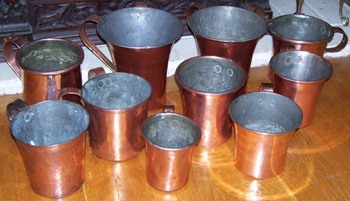
Different sized and construction Russian Copper beer mugs with one, two and three handles, all in the S M & T ‘s collection: “From Which To Drink.” Ca. MID 1700’Ss-1850.
[Editor’s note 6-1-2013l Anyone interested in Copper, or old mining should enjoy reading this article I did! ~
http://www.rawstory.com/rs/2013/06/01/mes-aynak-afghanistans-buddhist-buried-treasure-faces-destruction/
Russian copper and brass pots and mugs, such as those shown above were used out in the country side for serving beer in taverns as well as for other liquids. These are the equivalent of the multitude of almost the same shaped, lidless pewter vessels used in the United Kingdom taverns for the last 100’s of years.
Out in the Russian hinterlands there was never any formal “volume inspection and marks” such as was done in United Kingdom & France, and to a very limited degree in Germany with the use of their pre-sale capacity marks on manufactured beer steins in the mid to late 1800’s. This country, Russia, was just too damn big! The country did have tax collectors though and why they never tapped this ‘money market’ as Western Europe did, I have not found out. I can only assume that the process of riding horses from tavern to tavern out in the Russian Boonies would have been not worth the effort. Russia today, as it was in the 1800’s, without all its satellites, is still 1.8 times as large as the USA! Here are the 2000 STATS FOR AREA = SQ MILES:
| United States | 3,718,691 |
| Russia | 6,592,735 |
Quoted from an early 1900’s New York City newspaper article:
“Quaint Pieces of Copper and Brass Sought After, Cooking Utensils used as Jardinières—Family Loving Cups—Porringers and Samovars—Cossack Water Bottles”
“Some of the most attractive ornaments of the Newport villa of a well-known young New York matron are old pieces of Russian brass, iron, and copper, of which she purchased a number in a Russian shop in New York. Among these is a quaint pair of andirons, three feet in height, hammered out by hand, as all Russian metalwork is. A beautiful jardinière, which is the envy of all her friends, is another Russian antique. It is a large piece with three legs and monstrous lions’ heads on either side, all in copper and brass.”
“Handsome pieces of Russian copper, which ornament the house of a man who is a connoisseur of such things are large copper pots showing the marks of the hammer in their hand-shaped sides. The extreme diameter of 36 inches is a little above the centre, for the jars are small at the top and then bulge suddenly and gradually taper down to the bottom. They stand at the foot of steps leading to the house and have big palms set in them.”
A two handled drinking mug with old “dove-tailed seam”, rolled lip and Russian made “signature” heart finial on the end of the handle. Circa 1825 -50.
(Cont.) “These are modern copies of the antique, but are made of the beautiful copper for which Russia is famous, hammered from a single sheet of metal and soldered with brass at the side in a zigzag seam, which has been a characteristic of Russian work for centuries. The grandsons and great-grandsons of the ancient workmen are carrying on the work of their fathers in exactly the same manner, though with perhaps slightly increased facilities since the supply has to meet a large foreign demand. The modern reproductions of Russian antiques as well as of beautiful old French designs, taken frequently from books, is an import work, though it is done with the old methods and by the Russian workmen in Russian, where labor is so cheap that these objects can be imported and sold for a comparatively nominal sum.”
“A Russian, who is one of the dealers in the antique row on Fourth Avenue, and does a large business in both the antique and modern metals, has factories in St. Petersburg, Odessa, and Moscow, and a corps of men scour that country gathering antiques as this country has been scoured for Colonial china and house furnishings.”
Russian copper “beer pot” with the top of the piece bent outwards to form the lip. 10 inches tall. These are of the type used in the taverns to take beer to the table (and yes they had other uses too.) Again with the heart finial on the handle. These pots sell for some handsome prices at New York’s “Lower East Side Restoration Project” (anywhere from $499.00 to $550.00.)
See: http://www.russiansamovars.com/ click on the “copper pot” photo on the home page.
The above pot is shown in uncleaned condition. For how I clean and polish, please see: http://www.steveonsteins.com/how-i-clean-old-copper-brass-pewter-and-silver-10-20
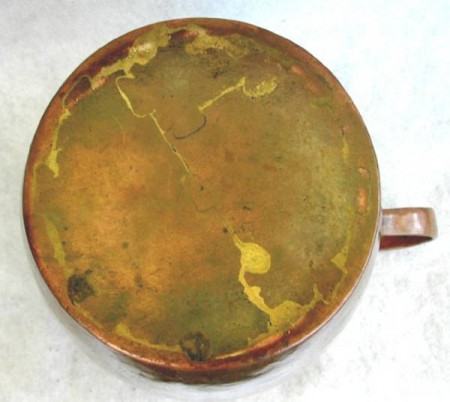
The early “dove-tailled seam” work on one of these jugs in the collection shows how every bit of scrap copper in the shop was used.
(Cont.) “There is also an establishment in this country with Russian workmen where Russian goods can be repaired, and samovars, which have been taken to pieces, can be put together by men who understand their construction. It is not a pleasant establishment to visit any more than the Russian factories, for the work is done with simple implements, a hammer and something like a blacksmith’s anvil, and the din as the metal is shaped is frightful.”
Above and below – two different very early South Russian “heavy-hammered” copper mugs, each with a dovetailed seam down the middle of the rear. The handle is made from one piece folded over on the inside for additional strength. Heavy rivets are used and the flattened inside ends are easy to feel. For more comparisons on handles see the bottom of this page.
These two do not have a rolled lip as some of these do, and as the ones made around Moscow examples do. These have intentionally pushed up bottoms very much like renaissance glass. 5 inches tall. Circa 1700’s.
(Cont.)
THE RUSSIAN METAL WORKER
“The Russian who has the New York shop is a practical metal worker, who learned his trade in Russia under the conditions and with the small returns that an apprentice receives in that country. The apprentice pays $30 or $35 on making his agreement for five years. The first year he gets nothing; the second $10, equal to $5 of our money; the third $15; the fourth $20; and the fifth year he has returned to him the money he paid in at first. His hours as apprentice or workman may be from 5 A.M to 12 P.M., any time that is required of him. After he is a full-fledged workman he receives pay for his work, but in proportion to what he has received as an apprentice.” (Cont. ▼)
This one is 4.5 inches tall. Circa 1700’s also.
“(Cont.) The quaint old cooking vessels which have belonged to peasant families for generations are all in copper, with the seams of brass, and where after a century of wear they have been repaired, a big patch is to be seen. One copper pot, which is shaped like nothing so much as a Boston bean pot, though with perhaps rather more aristocratic outlines, had a copper patch put on the side and held on with big brass bolts almost large enough to hold a safe door. It had been repaired at home by the peasant owner. It was charmingly picturesque so a New York man thought, and he bought it immediately for use as a jardinière.” (Cont. ▼)
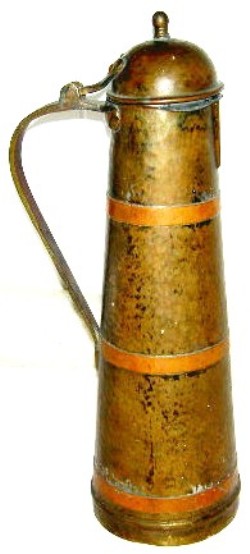
A tall, slender and filthy Russian copper with brass decorative rings beer server There is a small lip which is hard to see. Moscow area, pre-revolutionary.
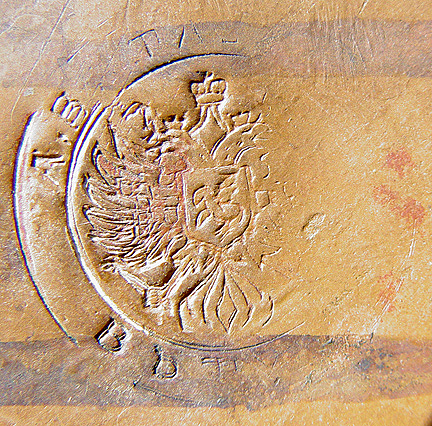
Typical mark found on the bottom of the Moscow area vessels.
.
Below ▼, some other similair marks used on these type vessels.
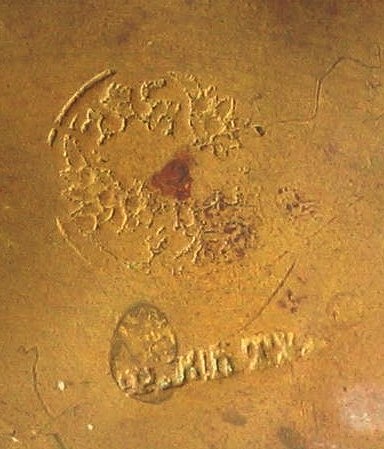
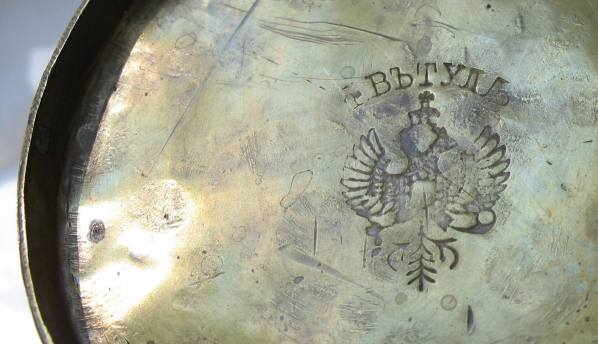
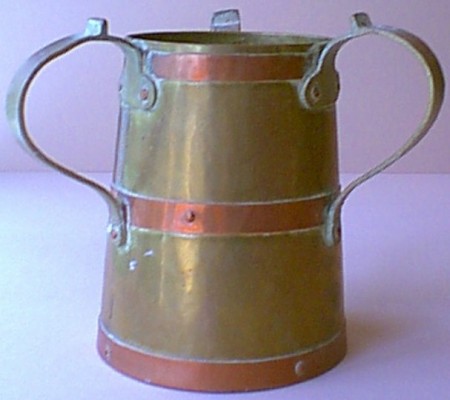
Some of these three handled “pass cups” made of both brass and copper can be found from the Moscow area with pre-revolution marks stamped into the bottom. They have the same top handle to body attachment process but not the heart finial on the bottom (I think that is because they are later made, say 1880’s onward.) Same maker as with the server above, probably.
For more info on “Pass Cups” see: http://www.steveonsteins.com/pass-cups-a-short-history-new-12-26-10
There are of course a few exceptions to “the rule” of having heart finial on the handles., as shown just above. Below is another ▼. I think this vessel is a wine server, or maybe for vodka shots. . One would fill it from the capped side and pour it from the other Seems like a big waste of time to us in the 2,000 years but back then lots of folks did it this way. Non the less this is a marked prerevolutionary piece.
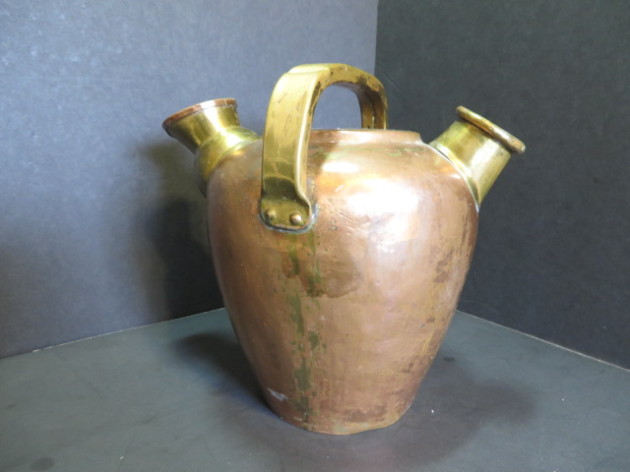
Also the rivets anchoring the handle are different than normal also.
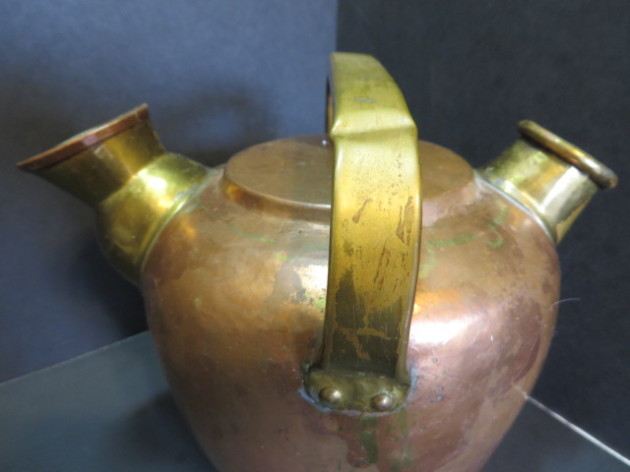
Close up.
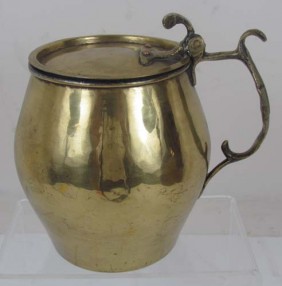
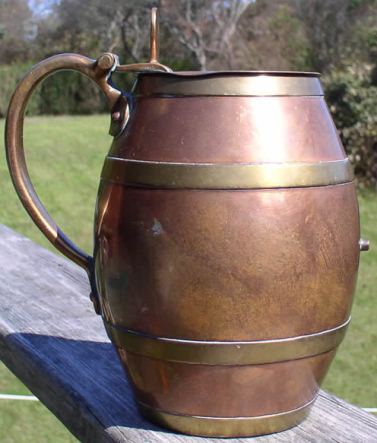
.
![( - RUSSIAN WITH bung hole [q] DIFFERENT](http://www.steveonsteins.com/wp-content/uploads/2010/05/RUSSIAN-DONT-I-WITH-bung-hole-q-DIFFERENT-273x450.jpg)
Also found in fairly good quantities still today are what we would call Brass and Copper “Barrel steins.” The old Pre-revolutionary Russians made them basically four ways, [a] Copper with brass, [b] Brass with copper, [c] all brass, [d] all copper.
The body and handles changed very little over time. Many of these were made and the lids do not fit 100% as they were mass produced with very little quality control. [see below] One must also watch that the lid goes all the way back or you can lose an eyeball when lifting it to your mouth.
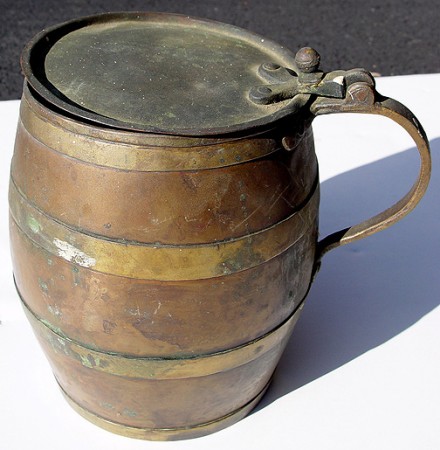
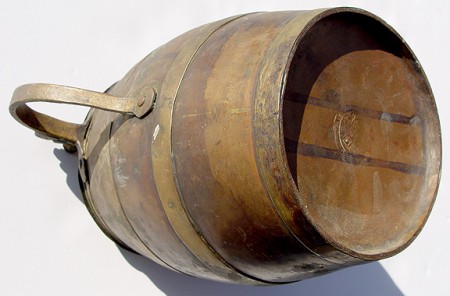
Showing the bottom construction. and a round handle atachment; lots of these are heart shaped.
(Cont.) “An old loving cup, which the lips of many generations had worn half away at one side, was picked up by an enthusiast as a great treasure. These loving cups, as they are called in English parlance, have their own significance in Russia.”
The older two and three handled copper mugs have: [1] a lip rolled over and iron ring lip for great stability and use, [2] an indented, separately made bottom that was soldered into place. On the much older ones small dabs of the lead solder were just left on and not buffed off – as shown on the bottom rim above. “Hell it’s only a beer mug [!] the maker might have said.”
(Cont.) “They are large cups with two handles as close together as two of the handles would be on a modern three-handled loving cup. They are used at weddings, where the peasant bride and bridegroom stand in all their gala attire, each holding a handle of the cup, which is filled with native wine. Each member of the family comes to drink from it as they hold it: the bride then drinks half of the remainder, and the bridegroom finishes it. The cup itself passes from generation to generation.”
Editor’s note: Also see Bethrothal Cups”, in this site’s Compendium.
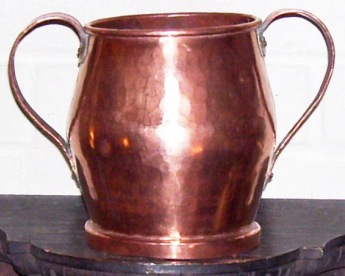
A newer type copper “pass mug” with added larger base and with brass handles. It has a much smaller and non-reinforced lip. Circa EARLY 1900s.
(Cont.)“There are copper teakettles galore and in all sizes, and frying pans as well. An interesting old piece, which looks like a muffin pan, is for the Saturday cakes of the Russian Jews. It is shallow, three-cornered, and has a long handle like a frying pan, but in the three-cornered surface are three depressions, into which the dough for the sweet Saturday cakes is placed to cook.”
(“Quoted” from The New York Times. Published August 5, 1900.
Copyright @ The New York Times)
Below: Comparisons of the making of copper vessel handles in a couple of European countries:
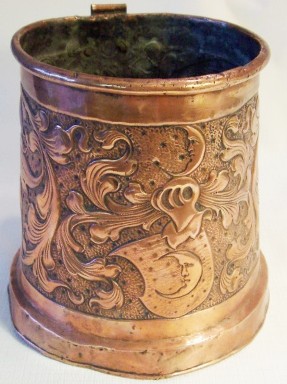
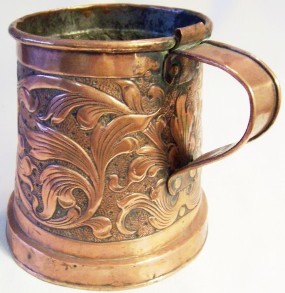
A Bohemian mug from the early 1700’s – notice the difference in the handle construction from that of the Russians. There is no handle end finial in the shape of a heart , or a rounded end (shown below ▼), both attached with a single rivet, which are very Russian.
On the earliest Bohemian steins / mugs the sides of the handles are rolled over on top for additional strength. Later ones may be found with the edges straight up but not folded, and it actually makes it hard to hold onto.)
On the Russian pieces (above) they may be folded over. BUT: The Russian pieces do not have elongated handles that come further down the body that look like a big “?” mark, such as found on the older Bohemian pieces. See the 3 liter Bohemian serving stein example just below ▼:
Also the Russian pieces seldom (if ever) had stippled work on the bodies of their average drinking vessels.
A Bavarian copper stein from the early 1900’s, probably Nurnberg. Again notice the difference in the handle construction from that of the Russians.
SEE: http://www.steveonsteins.com/copper-stein-bohemian-vs-bavarian
HANDLE ATTACHMENTS
Also please pay attention to how the top of the handle is connected to the body on the Russian drinking vessels . Below:
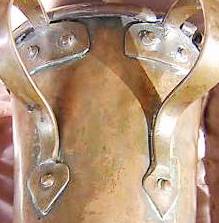
Based on rim constructiona nd the under rim oxidation : Ca. 1850-90
The photo below is of a Persian / Ottoman style copper mug where they consistently used a style of what I call, for the lack of a better term used elasewhere: “Condor wings.” Also note there is no rivet fastener on the bottom of the handle. Example is dated 1910.
![condor wings - TURKEY - PERSIA -OTTOMAN - REAR DATED 1904 -TURKEY [Q] ,HAS BOTTOM RIM- NO HOOK ON HANDLE - 6.5 INCHES](http://www.steveonsteins.com/wp-content/uploads/2010/05/condor-wings-TURKEY-PERSIA-OTTOMAN-REAR-DATED-1904-TURKEY-Q-HAS-BOTTOM-RIM-NO-HOOK-ON-HANDLE-6.5-INCHES.jpg)
RUSSIAN COPPER – ONE, TWO AND THREE HANDLED CUPS – OTHER DOCUMENTED USEs:
“NETILLAT YADAYIM” VESSELS” and “BETROTHAL CUPS”
.
(A COPY OF AN EMAIL TO ANOTHER COLLECTOR ABOUT THE SUBJECT.)
—– Original Message —–
From: Stephen L. Smith
To: Harry G.
Sent: Sunday, December 06, 2009 10:01 PM
Subject: Copper Hand washing Cups
Well Harry, you asked:
To start with I’ve been a beer stein, tankard and drinking vessels collector for over 38 years now. I also have a small collection of different “wedding cups” from all over the world. “One of” the latest sub-sets in the Smith collection has been copper and brass drinking vessels – see photos of a some of them taken last year- there is a 2 handles mug shown.
I’ve recently really gotten more into the pre-revolution Russian copper mugs and jugs.
There is a lot of mis-information out there about these two (and even single) handled copper mugs.
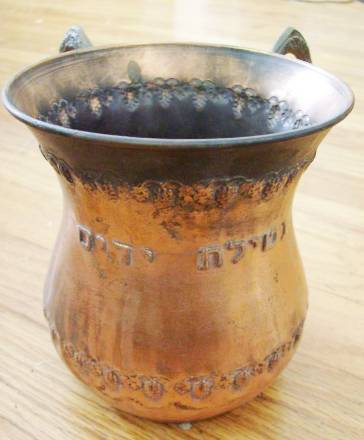
As you said — they can and were used as Jewish hand washing vessels = “NETILLAT YADAYIM” VESSELS. Ca. early 1800’s
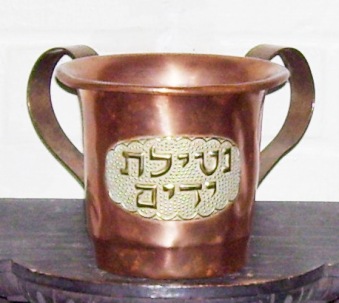
A Jewish copper hand washing cup made in Mexico. 5 inches tall.
I thought the fact that the little un-tinned one I got from you was made in Mexico was a hoot: = for Jewish tourists in Mexico City?, for the resident Jewish population?, or for export? , it all bears further study.
However what a lot of people don’t know is that they were also used by the general populace, mostly orthodox Russians as [1] betrothal cups and or wedding cup, and [2] communal “pass cups”: in taverns and at house parties.
The attached early NY Times article details only one way they were used for marriages. (SEE ARTICLE IN BLUE ABOVE, THIS WEB PAGE)
Little known in America is this fine custom: The two handled mugs were also used a “betrothal cups” in the areas all over Europe where there were visiting priests (known as the “padres” )only showed up in the local villages every 6 months or so. The partners to be married would drink from one of these in front of the village people and they were “unofficially married” = or betrothed by drink , until such time as the priest showed up to do “their legal [in the eyes of the church] thing.”
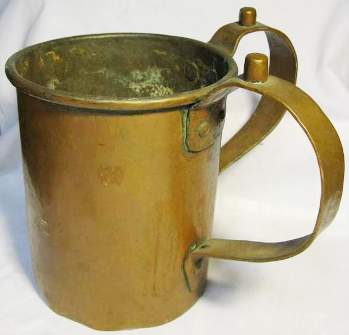
Circa 1870
A Russian copper “betrothal cup” with unusual attached peg thumb holders. 7 3/4 inch. These holders are usually found to be part of the handle that has been bent up and then back down to serve the same function as these pegs.
The way to drink from them in this instance was, the man had hold of the handle furthermost from him and the lady held by using the other handle, the one closer to the male. When the cup is raised to their mouths this way, the lips come together and both parties can /should sip from the cup at the same time.
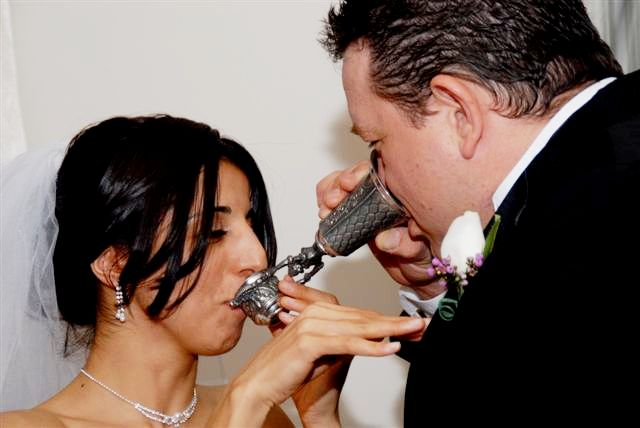
This sipping together is the basis for most true “marriage / wedding cups” including the German “Jungfrau Beaker’ which has two cups, the top one swings on a swivel so the lady can drink from it at the same time the gentleman does.
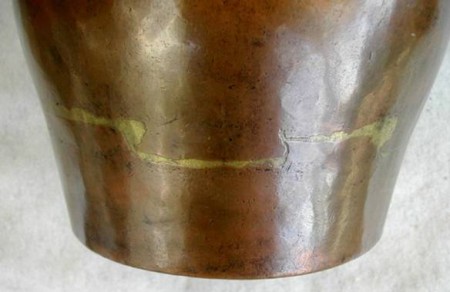
“Dovetailed seam” work from any county usually is apparent on any work done prior to the so called ‘Industrial Revolution’ = Steam power. It was in use in 90% of Eastern Europe by 1875. Being such a huge country, this date may not apply to Russian vessels.
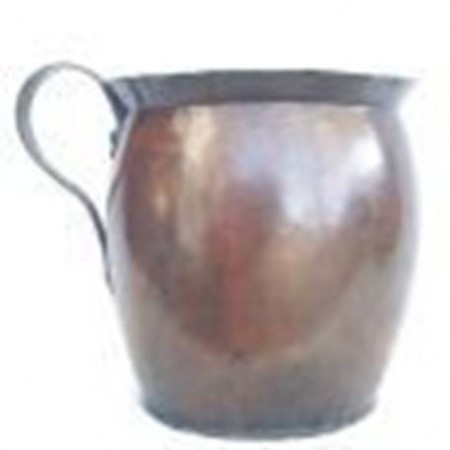
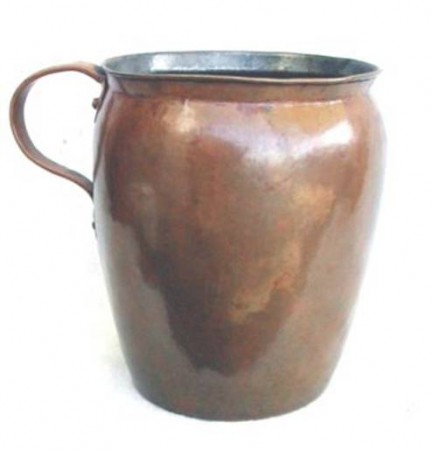
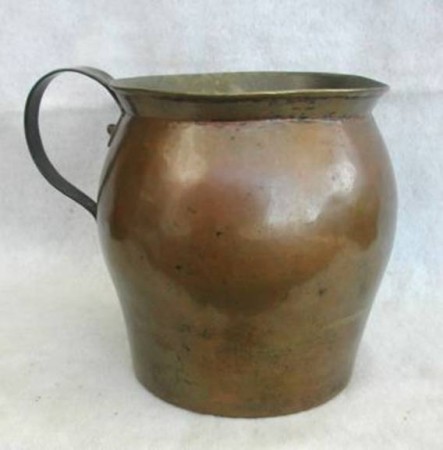
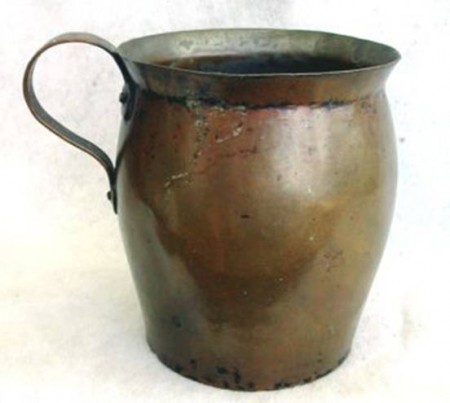
Above: four variants of standard Russian tavern copper beer jug / server; a pretty stock design. All for sale in NYC in mid – 2011. The cheapest was about $350.00. They can certainly be found on the “antiques for sale web sites (Ebay, Etsy, etc) for as lot less.
[END – SOK – 36 (+ 9) – R5]
STEVE (STEPHEN) =
 “All of us could take a lesson from the weather. It pays no attention to criticism.”
“All of us could take a lesson from the weather. It pays no attention to criticism.”


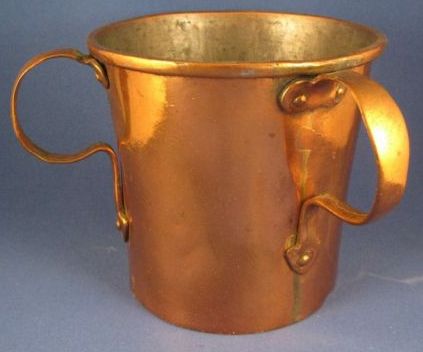
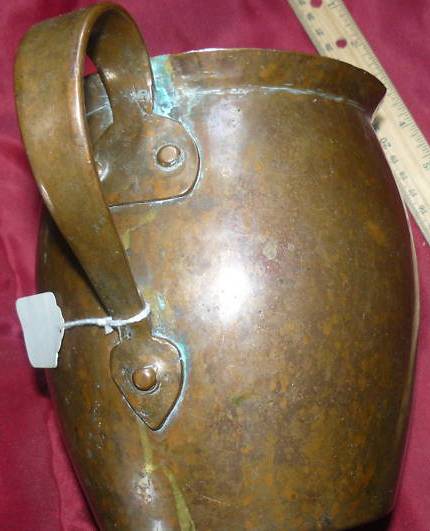
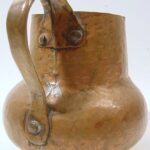
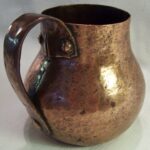
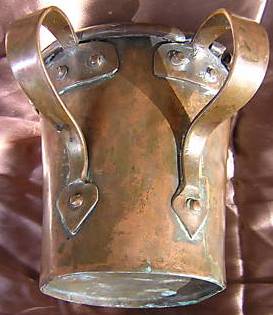
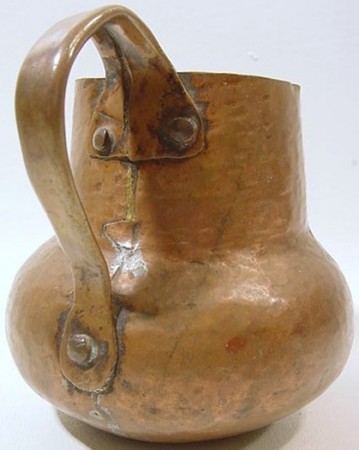
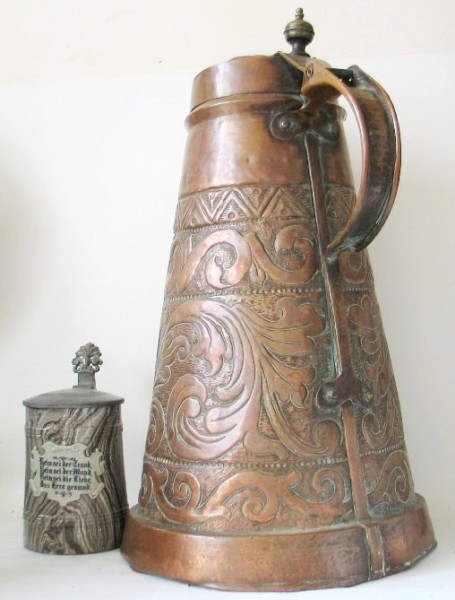
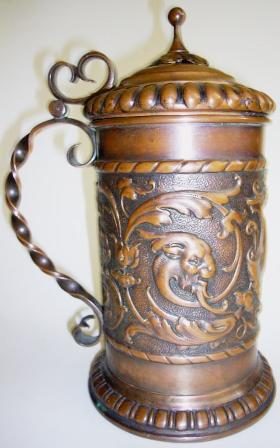
Leave a Reply